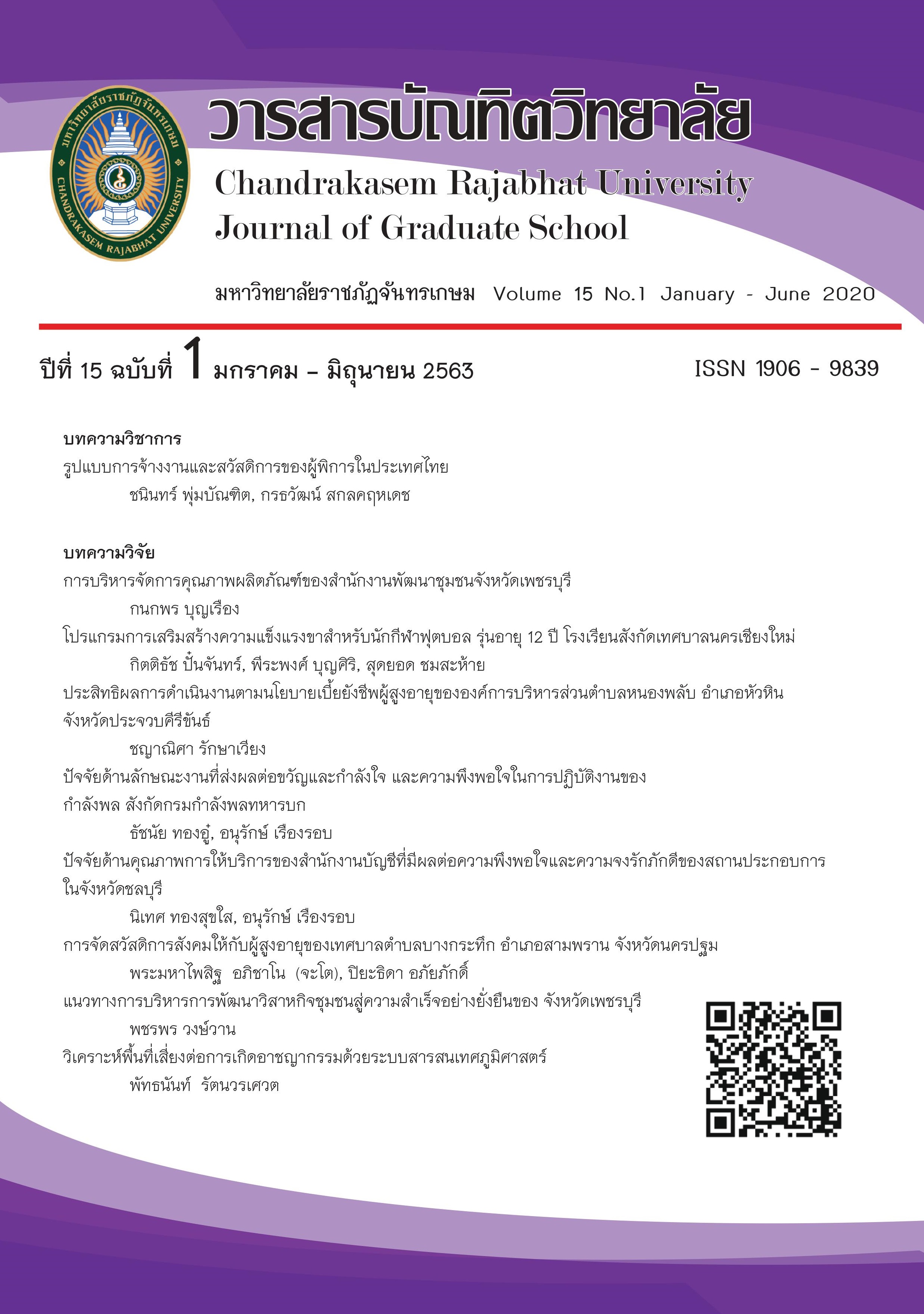รูปแบบการจ้างงานและสวัสดิการของผู้พิการในประเทศไทย
Main Article Content
บทคัดย่อ
บทความวิชาการนี้ได้นำเสนอมุมมองในด้านการจ้างงานและการจัดสรรสวัสดิการจากมุมมองผู้พิการ สถานประกอบการและสังคมรอบข้าง ทั้งนี้ จากการทบทวนวรรณกรรมยังพบว่าในบริบทการจ้างงานผู้พิการในประเทศไทยมีการขับเคลื่อนทั้งในระดับนโยบายและการใช้กฎหมายซึ่งเป็นปัจจัยในการขับเคลื่อนให้ผู้มีส่วนได้ส่วนเสียในระบบการจ้างงานและการจัดสรรสวัสดิการต้องมีการกำหนดแนวทางทั้งทางด้านการพัฒนาอาชีพ ทักษะและองค์ความรู้ของผู้พิการให้เหมาะสมกับการจ้างงานในแต่ละรูปแบบ ทั้งนี้ยังเป็นการให้สิทธิในการทำงานและแสดงศักยภาพของผู้พิการ โดยสถานประกอบการมีโอกาสได้รับสิทธิประโยชน์ตามนโยบายการจ้างงานผู้พิการในระดับประเทศ เพื่อการขับเคลื่อนประเทศและสิทธิมนุษย์ชนอีกด้วย
อนึ่ง นำไปสู่การเสนอรูปแบบการจ้างงานและสวัสดิการของผู้พิการในสถานประกอบการของประเทศไทย วัตถุประสงค์ในการศึกษาเพื่อทบทวนวรรณกรรมและเอกสารที่เกี่ยวข้องเพื่อนำไปสู่การสร้างแนวทางการพัฒนาระบบการจ้างงานและสวัสดิการของผู้พิการให้มีคุณภาพที่ดีขึ้น
Article Details

อนุญาตภายใต้เงื่อนไข Creative Commons Attribution-NonCommercial-NoDerivatives 4.0 International License.
เอกสารอ้างอิง
กรมส่งเสริมและพัฒนาคุณภาพชีวิตคนพิการแห่งชาติ. (2558). พระราชบัญญัติส่งเสริมและพัฒนาคุณภาพชีวิตคนพิการ พ.ศ. 2554. สืบค้นจาก http://dep.go.th/?q=th/law/act.
กรมส่งเสริมและพัฒนาคุณภาพชีวิตคนพิการแห่งชาติ. (2558). เอกสารชุดความรู้มาตรฐานคุณภาพชีวิตคนพิการปี 2561. สืบค้นจาก http://dep.go.th/?q=th/ประเภทเอกสารเผยแพร่/งานวิจัย.
กิจการเพื่อสังคมไนส์คอร์ป. (2556). เอกสารการสัมมนาคณะไตรภาคี งานแถลงทิศทางการส่งเสริมการสร้างงานคนพิการ ปี 2556 (วิทยานิพนธ์ปริญญามหาบัณฑิต). กรุงเทพฯ: มหาวิทยาลัยธรรมศาสตร์.
ทวี เชื้อสุวรรณ. (2552). รูปแบบการฟื้นฟูสมรรถภาพคนพิการที่เหมาะสมกับชุมชนพุทธมณฑลปฏิบัติของไอแอลโอ. สืบค้นจาก https://www.ryt9.com/s/cabt/107110.
มูลนิธิพระมหาไถ่เพื่อพัฒนาคนพิการ. (2552). ระบบสนับสนุนการจ้างงานคนพิการในตลาดแรงงานเปิด. กรุงเทพฯ: สำนักงานส่งเสริมและพัฒนาคุณภาพชีวิตคนพิการแห่งชาติ.
สุภรธรรม มงคลสวัสดิ์. (2544). แนวทางการส่งเสริมอาชีพคนพิการ (โครงการสวัสดิการสังคมบัณฑิตวิทยาลัย). กรุงเทพฯ: มหาวิทยาลัยหัวเฉียวเฉลิมพระเกียรติ.
องค์การแรงงานระหว่างประเทศ. (2553). การจัดการเพื่อสนับสนุนคนพิการในสถานประกอบการ: แนวปฏิบัติของไอแอลโอ. กรุงเทพฯ: สำนักงานกลุ่มประเทศเอเชียตะวันออกองค์การแรงงานระหว่างประเทศ.
Abdullah, M. N. L. Y., Mey, S. C., Eng, T. K., Othman, R., & Omar, A. F. (2013). School-to-work transition services for students with disabilities in Malaysia: organizations’ views on policy and practices. Journal of Research in Special Educational Needs, (4), 259-272.
American Foundation for the Blind. (2018). Annual Report. Retrieved February 16, 2019, Retrieved from https://www.afb.org.
Ang, M.C.H., Ramayah,T., & Vun,T.K. (2013). Hiring Disabled People in Malaysia: An Application of the Theory of Planned Behavior. Journal of International Social Research, 6(27), 50.
Barnes, C. & Oliver, M. (1993). Disability: A Sociological Phenomenon Ignored by Sociologists. Leeds: University of Leeds.
European Commission. (1998). European Economy 1998. Retrieved March 15, 2019, Retrieved from http://ec.europa.eu/economy_finance/publications/european_economy/1998/index_en.htm.
Gustafsson, J., Peralta, J. P., & Danermark, B. (2013). The employer’s perspective on Supported employment for people with disabilities: Successful approaches of supported employment organizations. Journal of Vocational Rehabilitation, 38(2), 99–111.
Hammerman, S. & Maikowski, S. (1981). The Economics of disability: Internationalperspectives. New York: Rehabilitation International.
Harris, S. P., Renko, M., & Caldwell, K. (2013). Accessing social entrepreneurship: Perspectives of people with disabilities and key stakeholders. Journal of Vocational Rehabilitation, 38(1), 35–48.
Harvey, J., Szoc, R., Rosa, M.D., Pohl, M., & Jenkins, J. (2013). Understanding the
Competencies need to customize jobs: A competency model for customized employment. Journal of Vocational Rehabilitation, 38, 77-89.
International Labour Office. (2013). Global Employment Trends 2013. Retrieved March 15, 2019, Retrieved from https://www.ilo.org/wcmsp5/groups/public/---dgreports/---dcomm/---publ/documents/publication/wcms_202326.pdf.
Tan, B.-L. (2009). Hybrid transitional-supported employment using social enterprise: A retrospective study. Psychiatric Rehabilitation Journal, 33(1), 53–55.
United Nations. (2018). Human Development Report. Retrieved March 15, 2019, Retrieved from http://hdr.undp.org/sites/default/files/hdr14-report-en-1.pdf.


